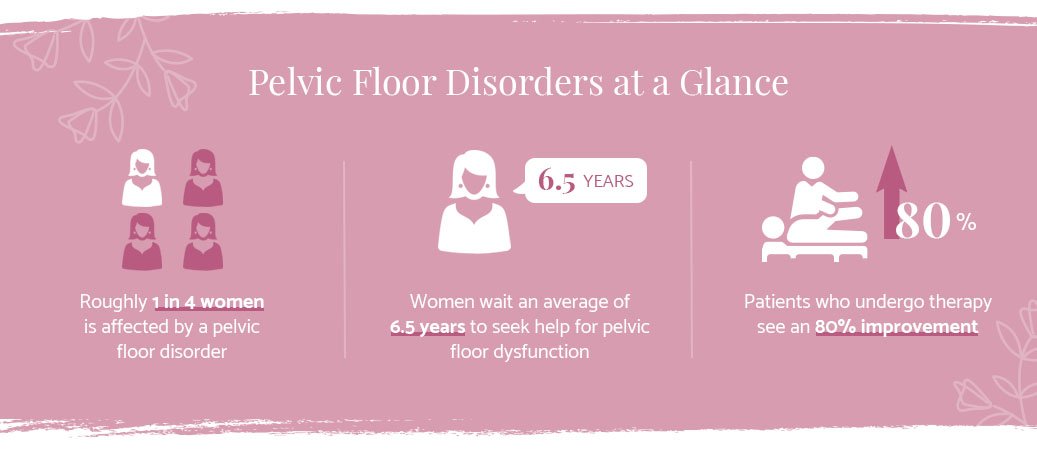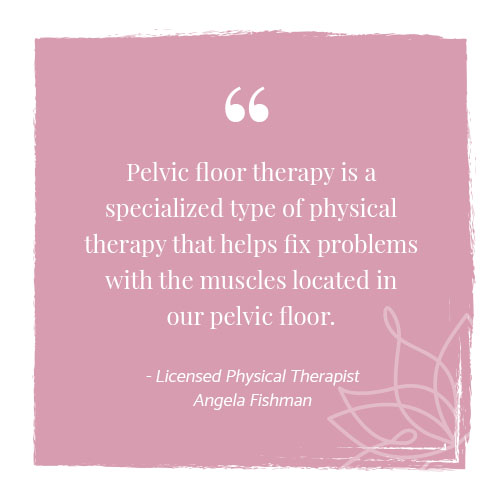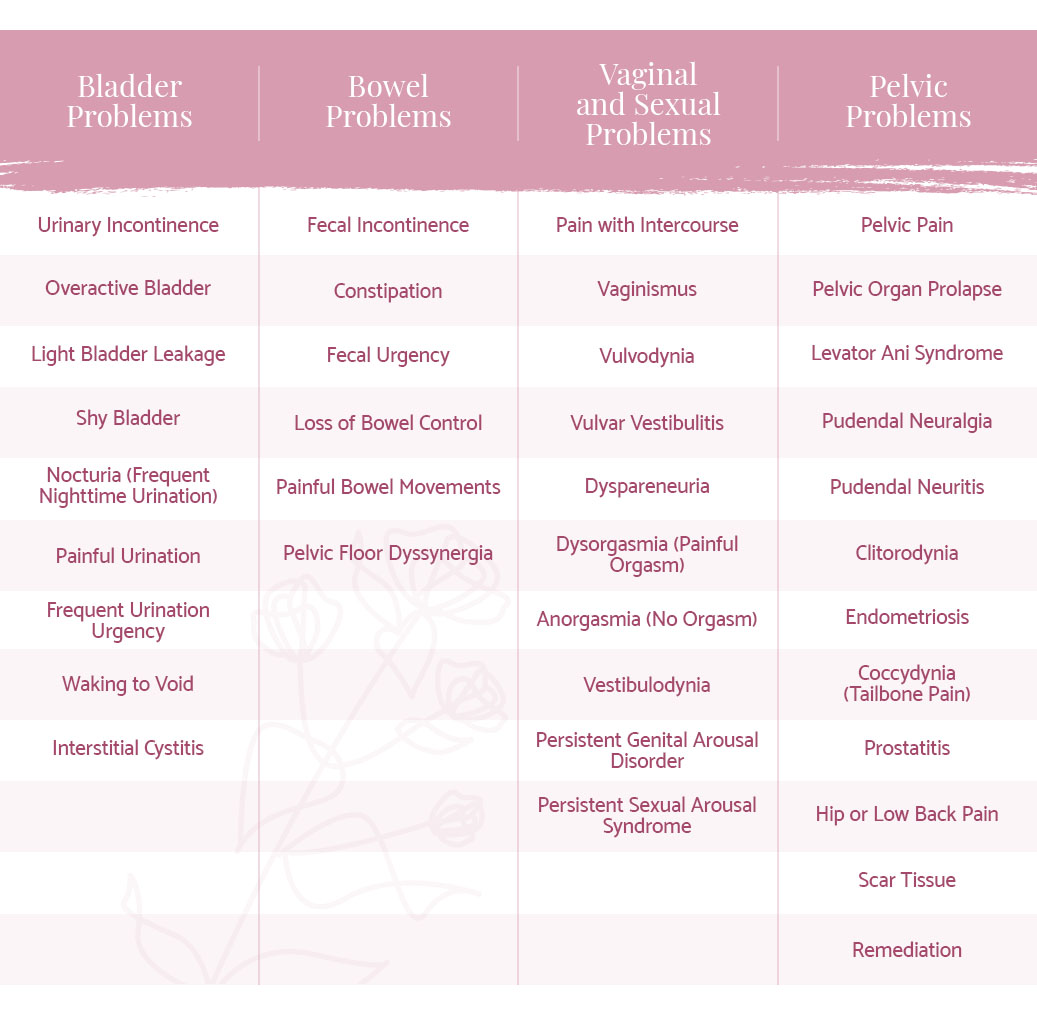
What Is Pelvic Floor Therapy?
We all know physical therapy can be used to treat common conditions, like a torn meniscus or osteoarthritis, but did you know it’s also useful in the treatment of urinary incontinence, painful sex, and endometriosis? The systems that scaffold our sexual and urinary health are made up of muscles, just like those in the legs, back, and neck. And muscles are surprisingly resilient and adaptable, so they can be trained in a variety of ways.

Pelvic Floor Disorders at a Glance
Roughly one in four women is affected by a pelvic floor disorder.
Women wait an average of 6.5 years to seek professional help for pelvic floor dysfunction.
Patients who undergo therapy for pelvic floor dysfunction see an 80 percent improvement.
The fundamental training principles employed in physical therapy can be applied to the pelvic floor muscles, which can in turn help treat a variety of women’s health issues. But what, exactly, does pelvic floor physical therapy entail? Who can benefit from it? Can it be done at home? Can it help with bladder leakage? We know you’ve got a ton of questions on the topic. And with the help of a few experts, we’ve got the answers!
The Basics: What Is Pelvic Floor Therapy?
Let’s start with the basics. What, exactly, is pelvic floor therapy? For the answer, we turn to Licensed Physical Therapist Angela Fishman, owner of My Pelvic Therapy. “Pelvic floor therapy is a specialized type of physical therapy that helps fix problems with the muscles located in our pelvic floor,” says Fishman. “Because these muscles surround the openings in our pelvis, they play a critical role in how our body functions.”

So does it work? “Pelvic floor physical therapy treatment is very effective — it is considered first-line treatment for most pelvic floor dysfunctions,” says Fishman. According to one study, patients who underwent therapy for pelvic floor dysfunction saw an 80 percent improvement in three areas: urinary incontinence, bowel dysfunction, and pelvic pain.
What Conditions Can Pelvic Floor Therapy Treat?
Fishman says there are a few main categories of “pelvic floor dysfunctions,” which are treated with pelvic floor therapy, including bladder problems, bowel problems, and vaginal problems. But there are dozens of specific conditions pelvic floor therapy can improve. Typically, these disorders develop when the muscles are either too weak (causing poor coordination) or too tense or tight (causing pelvic pain).

According to Doctor of Physical Therapy Heather Jeffcoat, owner of Fusion Wellness, the way the pelvic floor functions is closely linked to the rest of the body. “Pelvic floor therapy works on correcting pelvic floor dysfunction by addressing not only the pelvis, but how the entire body influences the pelvis,” says Jeffcoat. “This includes addressing posture, strength or flexibility imbalances, an unregulated nervous system, or correcting abnormal movements patterns in the pelvic floor and in the body as a whole.”
How Is Pelvic Floor Therapy Done?

This kind of therapy involves doing a series of pelvic floor exercises with the guidance of a physical therapist to help strengthen or loosen the muscles to achieve the desired result. If the patient is comfortable, physical therapists may use their hands to perform manual release and massage. The process also involves teaching patients stretches and techniques to strengthen or loosen muscles themselves at home.
Discover The Best Pelvic Floor Exercises for Urinary Incontinence
In fact, if you’ve ever done Kegels or used Kegel balls at home, you’ve already done some form of pelvic floor therapy. These exercises help strengthen the pelvic floor muscles and can help you control urinary incontinence and other issues related to the pelvic floor, but they’re not right for every situation. Because of the fact that many women actually need to loosen their pelvic floor muscles, Kegels aren’t used to treat all pelvic floor disorders.
“There are intravaginal and intrarectal techniques that can be performed depending on the patient's symptoms and findings,” says Jeffcoat. “The exact treatments depend on whether they have pain or incontinence or both. Generally with pain or any discomfort, the pelvic floor muscles are overactive and must be down-trained. With some incontinence diagnoses, it may be appropriate to work on strengthening exercises.”
Tips for How to Get Started with Pelvic Floor Therapy

“The first step is to find a qualified pelvic floor therapist,” says Fishman, who suggests consulting national directories — such as PelvicRehab.com or the directory of the American Physical Therapy Association — or calling your local physical therapy providers and inquiring if they provide pelvic floor therapy.
The experts say it’s crucial to take your time finding a therapist who’s well-vetted and properly trained. “Pelvic floor therapists should always hold a license that allows them to practice intravaginal or intrarectal techniques. This is not something a massage therapist or sexologic bodyworker should be performing,” says Jeffcoat.
Support at Every Stage of Life

Whether you’ve got questions about bladder training or are looking for the best urinary incontinence products for your needs, Sofia & Grace is here to help. Our resource center taps into expert insights, personalized recommendations, and the latest data to help women sail through every stage of life with confidence.